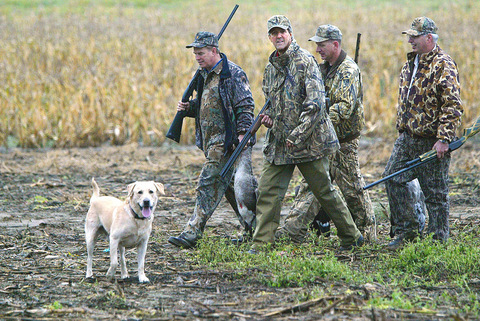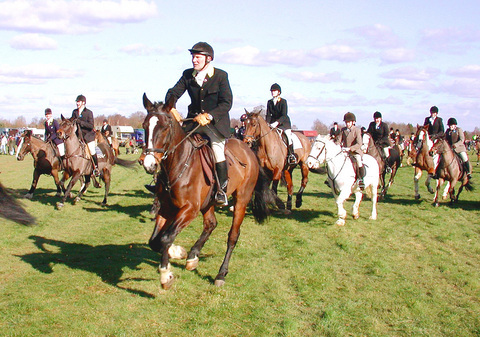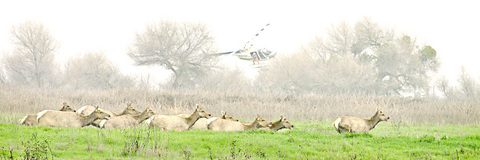Having long been a way for politicians to burnish their bonafides with rural voters, hunting is steadily morphing into a high-class pursuit for the wealthiest and well-connected, say local officials in this rugged brush land of South Texas where US Vice President Dick Cheney accidentally shot one of his hunting companions.
As the availability of public gamelands has shrunk, private outings to special preserves like the Armstrong Ranch, where Cheney accidentally fired his 28-gauge shotgun at Texas lawyer Harry Whittington earlier this month, are fast becoming the only way to share in one of the state's most fabled pastimes, many here complain.
So when local residents hear outsiders describe how big ranch hunts are typical for those who live in this part of Texas, many respond with a roll of the eyes. "If you don't know somebody who owns a big ranch or unless you're quite well off you don't get invited on these special hunts," said Chuck Shipley, 65, who runs the state's visitor center in Kingsville, 80km north on Route 77 of the Armstrong Ranch. "It's not like it used to be. It's pretty expensive to hunt in Texas."

PHOTO: NY TIMES NEWS SERVICE
But the cost means little to outside luminaries who gather at local ranches. Cheney was merely the latest in a stream of high rollers to hunt on one of the several massive ranches in the county, officials said.
"The big oil men, the chemical companies, all the bigwigs come down here to hunt," said Shipley. It's a far cry, he said, from the days when anyone with a rifle or shotgun could set out across the railroad tracks into the vast open spaces and hunt for deer, birds, and other varied wildlife found here.
Deep in the windswept plains of Kenedy County -- population about 400, with no restaurant or gas station in 2,253 square kilometers -- the Armstrong Ranch, like the nearby Kenedy and King ranches, has been host to presidents and princes.

PHOTO: NY TIMES NEWS SERVICE
Britain's Prince Charles once played a polo match on the 20,234 hectare spread in the Lower Rio Grande Valley between the Gulf of Mexico and the Mexican border. Both presidents Bush have been to the ranches here several times, according to locals.
Settled in 1882 by John Armstrong III, a lawman famed for capturing the outlaw John Wesley Hardin, it became the homestead for a powerful family that mixed rugged ranch life with Harvard and Yale educations and has been a fixture in Texas Republican politics for generations.
The founder's son, Tom, became one of the first executives for the Standard Oil Company in the early part of the 20th century. The late Tobin Armstrong, who died last fall, was a top fund-raiser for the Bush-Cheney reelection campaign, collecting more than US$100,000 in 2004.

There are an estimated 20 million active hunters in the US, according to industry groups. More than one million Texans alone apply for hunting licenses each year, according state wildlife figures.
And politics and hunting have long been inextricably linked here, as politicians have sought to embody the rugged individualism of the only state in the union that was once an independent republic.
"Hunting is deeply ingrained in our folklore and heritage," said Thomas Myers, a political science professor who teaches state government at Baylor University in Waco, Texas, and who grew up on a ranch. "Just like [former US president] Richard Nixon watched the Washington Redskins play football, here you go kill Bambi or some birds and you're part of one of the boys."
Former US president Lyndon B. Johnson was famous for driving his guests around his vast Texas ranch. US President George W. Bush, when he ran for governor in 1994, went hunting at the same event as his Democratic rival, then-governor Ann Richards, as each sought to burnish their credentials as average Texans.
Former US president Bill Clinton acknowledged in his memoirs that he believed Democrats lost to the Republicans in 2000 because they failed to appeal to hunters like Bush did. In 2004, both Bush and Democratic presidential nominee John Kerry devoted parts of their Web sites to hunters.
But hunting is no longer a surefire way to connect with blue-collar voters, say many in Texas. These days, the sport is more often associated with millionaires than backwoodsmen.
"In recent years there has been the sale of tens of millions of hectares of public lands for private mining and logging which is no longer accessible to the blue-collar hunter," said John Rosenthal, president and co-founder of the American Hunters and Shooters Association in Frederick, Maryland.
"The lack of access to public hunting lands is the number one reason that hunters drop out of the sport," added Bill Brassard of the National Shooting Sports Foundation in Newtown, Connecticut "There appears to be a trend toward pay-to-hunt operations."
On the King Ranch's 333,865 hectares, a one-day deer hunt costs at least US$1,000 per person, according to the ranch's Web site. Quail is US$450 per gun per day. A three-day outing could cost US$5,500 or more. In Sarita, the only town in county, where the elementary school for ranch workers' children and county offices are located, Diana Mata, the dispatcher for the Kenedy County Sheriff's Office, said she remains an avid deer hunter. But "unless you know someone on the property, it's not as easy to go hunting anymore."

March 31 to April 6 On May 13, 1950, National Taiwan University Hospital otolaryngologist Su You-peng (蘇友鵬) was summoned to the director’s office. He thought someone had complained about him practicing the violin at night, but when he entered the room, he knew something was terribly wrong. He saw several burly men who appeared to be government secret agents, and three other resident doctors: internist Hsu Chiang (許強), dermatologist Hu Pao-chen (胡寶珍) and ophthalmologist Hu Hsin-lin (胡鑫麟). They were handcuffed, herded onto two jeeps and taken to the Secrecy Bureau (保密局) for questioning. Su was still in his doctor’s robes at

A vaccine to fight dementia? It turns out there may already be one — shots that prevent painful shingles also appear to protect aging brains. A new study found shingles vaccination cut older adults’ risk of developing dementia over the next seven years by 20 percent. The research, published Wednesday in the journal Nature, is part of growing understanding about how many factors influence brain health as we age — and what we can do about it. “It’s a very robust finding,” said lead researcher Pascal Geldsetzer of Stanford University. And “women seem to benefit more,” important as they’re at higher risk of

Last week the Democratic Progressive Party (DPP) said that the budget cuts voted for by the China-aligned parties in the legislature, are intended to force the DPP to hike electricity rates. The public would then blame it for the rate hike. It’s fairly clear that the first part of that is correct. Slashing the budget of state-run Taiwan Power Co (Taipower, 台電) is a move intended to cause discontent with the DPP when electricity rates go up. Taipower’s debt, NT$422.9 billion (US$12.78 billion), is one of the numerous permanent crises created by the nation’s construction-industrial state and the developmentalist mentality it

Experts say that the devastating earthquake in Myanmar on Friday was likely the strongest to hit the country in decades, with disaster modeling suggesting thousands could be dead. Automatic assessments from the US Geological Survey (USGS) said the shallow 7.7-magnitude quake northwest of the central Myanmar city of Sagaing triggered a red alert for shaking-related fatalities and economic losses. “High casualties and extensive damage are probable and the disaster is likely widespread,” it said, locating the epicentre near the central Myanmar city of Mandalay, home to more than a million people. Myanmar’s ruling junta said on Saturday morning that the number killed had